
If you are looking to strengthen your upper body and build functional strength, you probably understand the importance of pull-up exercises. But the truth is that pull-ups can be challenging for many people, especially beginners or those without access to a pull-up bar. Luckily, we have you covered with a variety of effective pull-up alternatives that will help you achieve similar results without the need for a pull-up bar.
“What if I just don’t worry about pull-ups or the like?” you may be asking. Turns out that if you don’t incorporate upper body exercises in some form or fashion into your fitness routine you could limit your progress and hinder your overall strength development. Not to worry though, in this article we will introduce you to a thing called pull up alternative that targets the same muscle groups, allowing you to build upper body strength and improve your overall fitness level.
6 Effective Alternatives To Pull Ups For Upper Body Strength
Pull Up Alternative: Effective Workouts For Upper Body
Without further ado, here are our six pull-up alternatives to help you get started.
Inverted Row
The inverted row is an effective compound exercise that primarily targets the muscles of the back, such as the rhomboids and posterior deltoids. It is performed using a bar or suspension trainer, with the individual lying on their back and pulling their body upwards towards the bar.
This exercise not only helps to develop a strong back but also engages the core muscles for stability. By adjusting the grip width and body position, you can emphasize different areas of the back.
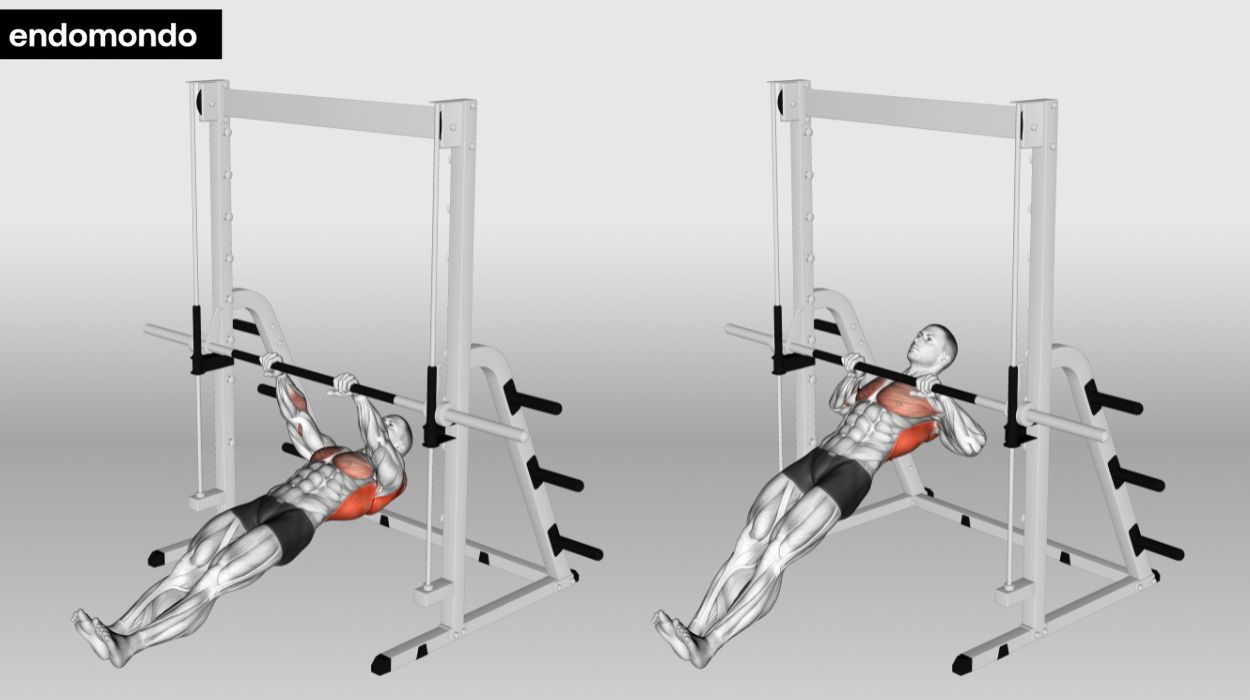
How to do:
- Set up a secure bar at waist height or use a suspension trainer like TRX.
- Grab the bar or handles with an overhand grip, hands shoulder-width apart.
- Hang underneath the bar with your arms fully extended, body straight, and heels on the ground.
- Pull your chest towards the bar by bending your elbows and squeezing your shoulder blades together.
- Lower yourself back down to the starting position with control, fully extending your arms.
- Repeat for the desired number of repetitions, focusing on engaging your back muscles throughout the movement.
Tips:
- Maintain a straight line from your head to your heels throughout the movement to engage your core and prevent sagging or arching.
- Keep your shoulder blades pulled back and down to fully engage your back muscles and promote proper scapular retraction.
- Lower your body down until your arms are fully extended, then pull yourself up until your chest touches the bar or handles, focusing on using your back muscles to initiate and control the movement.
Optimal Sets and Reps: 3 sets of 8-12 reps.
Renegade Row
Renegade rows are a challenging exercise that targets the muscles of the upper body, particularly the back, shoulders, and core. They are performed in a plank position with the hands gripping dumbbells or kettlebells. The movement involves alternating rowing one weight at a time while maintaining a stable core and avoiding rotation of the hips, which also helps to improve stability and coordination.
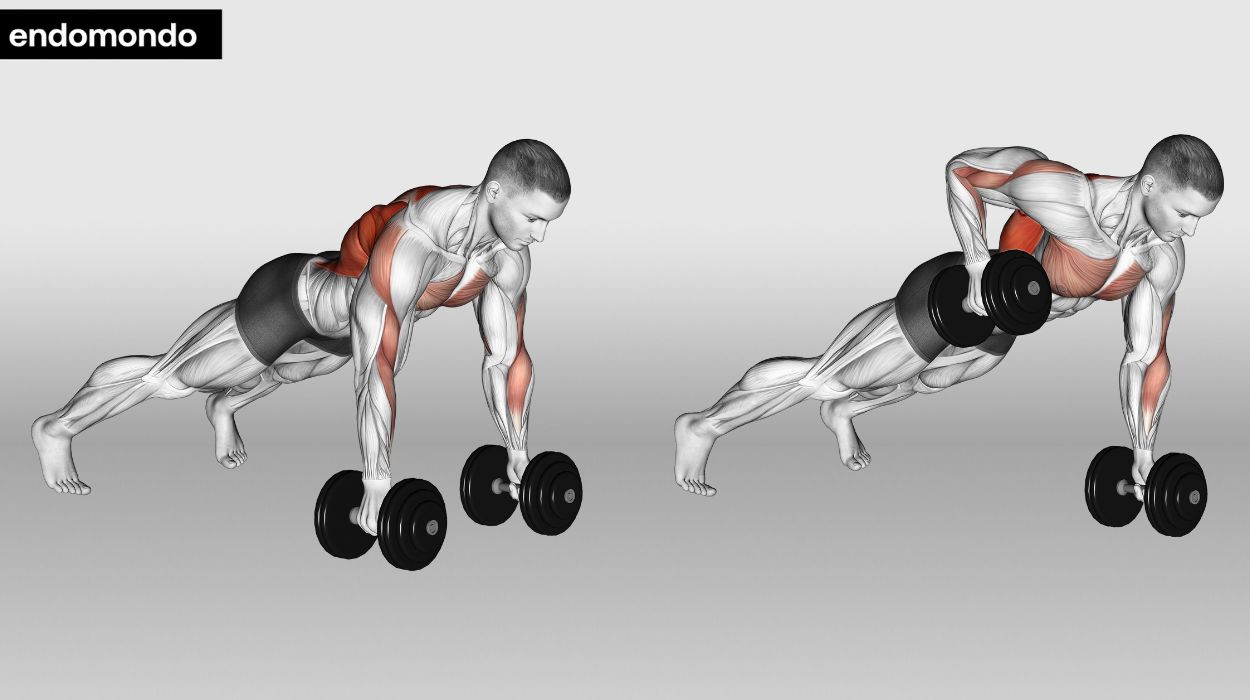
How to do:
- Start in a high plank position with a dumbbell in each hand, wrists directly under shoulders, and feet slightly wider than hip-width apart.
- Brace your core to maintain a stable spine and prevent rotation.
- Perform a row on one side by pulling the dumbbell towards your hip, keeping your elbow close to your body.
- Lower the dumbbell back to the ground with control and repeat the row on the opposite side.
- Continue alternating sides for the desired repetitions, maintaining a steady plank position throughout.
Tips:
- Maintain a strong plank position throughout the exercise to engage your core and stabilize your body.
- Keep your hips square and avoid rotating them as you perform the rows to maximize back and core engagement.
- Pull the dumbbell towards your hip while keeping your elbow close to your body to target your back muscles effectively.
Optimal Sets and Reps: 3 sets of 8-12 reps per arm.
Towel Row
The towel row is a variation of the rowing exercise that provides an additional challenge by using a towel as the gripping tool. It targets similar muscles as the inverted row, but, by using a towel, you introduce an element of instability, which requires greater muscle activation and coordination. This exercise helps to improve grip strength, upper back strength, and posture.
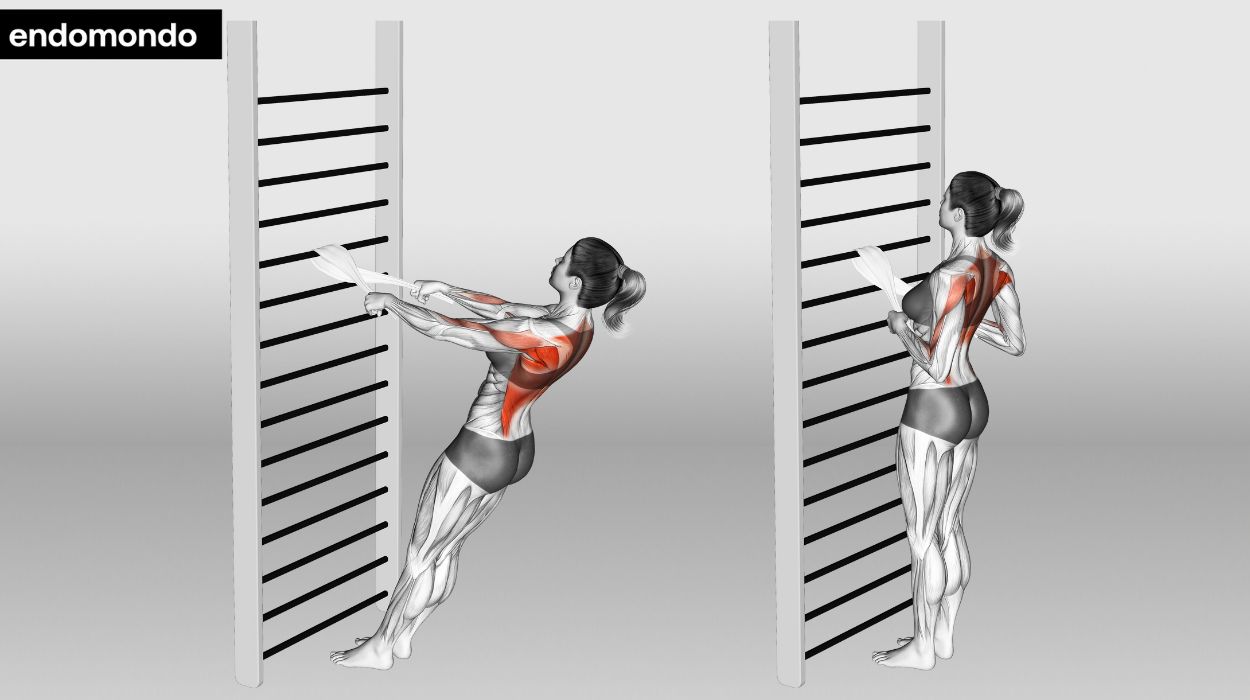
How to do:
- Begin by securing a towel around a sturdy horizontal bar or other elevated surface.
- Stand facing the bar and grip the towel handles with an overhand grip, palms facing towards you.
- Walk your feet back until your body is at an angle, leaning back slightly, with your arms fully extended.
- Pull your chest towards the bar by bending your elbows and squeezing your shoulder blades together.
- Lower yourself back down with control, extending your arms fully.
- Repeat for the desired number of repetitions, focusing on engaging your back muscles throughout the movement.
Tips:
- Maintain a strong and stable grip on the towel handles throughout the movement to ensure safety and effectiveness.
- Keep your body in a straight line from head to heels, engaging your core and glutes to stabilize your spine.
- Pull your chest towards the bar or anchor point by bending your elbows and squeezing your shoulder blades together, focusing on using your back muscles.
Optimal Sets and Reps: 3 sets of 8-12 reps.
Lat Pull-Down
The lat pull-down is a popular exercise that targets the latissimus dorsi muscles, located on the sides of the back. It is performed using a cable machine or a lat pull-down machine. The movement involves pulling a bar or handle attached to the cable down towards the upper chest while sitting or kneeling.
In addition to the lats, the exercise also engages the posterior deltoids, biceps, and forearm muscles. Lat pull-downs help develop upper body strength, improve posture, and enhance pulling movements.
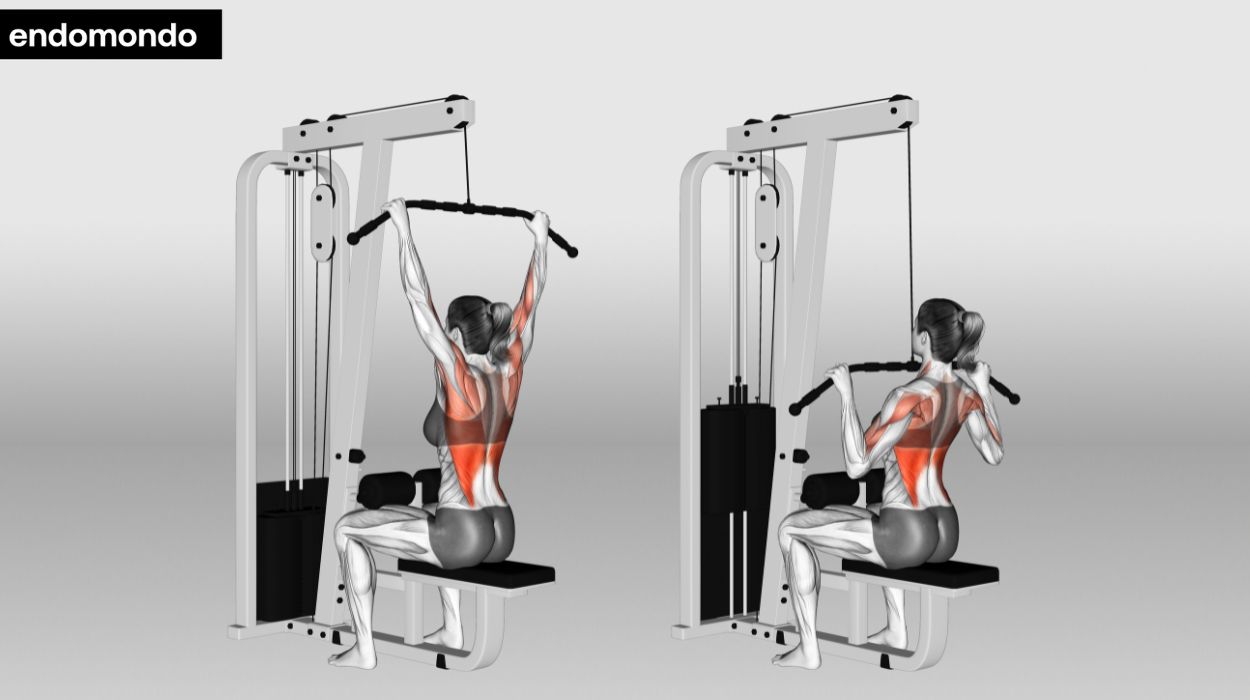
How to do:
- Sit down on the lat pull-down machine and adjust the thigh pads to secure your legs.
- Grasp the wide bar attachment with an overhand grip, hands slightly wider than shoulder-width apart.
- Pull the bar down towards your chest by engaging your lats and squeezing your shoulder blades together.
- Slowly release the bar back to the starting position, allowing your arms to extend fully.
- Repeat for the desired number of repetitions, focusing on maintaining proper form and control throughout the movement.
Tips:
- Sit upright with a tall posture and avoid leaning back excessively to ensure proper engagement of the lat muscles.
- Keep your shoulders down and back, avoiding shrugging, to maximize the activation of the lats and minimize the involvement of the traps.
- Pull the bar down towards your chest in a controlled manner, focusing on squeezing your shoulder blades together at the bottom of the movement.
Optimal Sets and Reps: 3 sets of 8-12 reps.
Close Grip Chin-Up
Close grip chin-ups are a variation of the classic chin-up exercise that primarily targets the muscles of the back too. They are performed by gripping a pull-up bar with an underhand grip, and hands placed closer together than shoulder-width.
The movement involves pulling the body upward until the chin is above the bar. Close grip chin-ups also engage the biceps and forearms. They are an effective exercise for building back and arm strength, as well as improving grip and overall upper body stability.
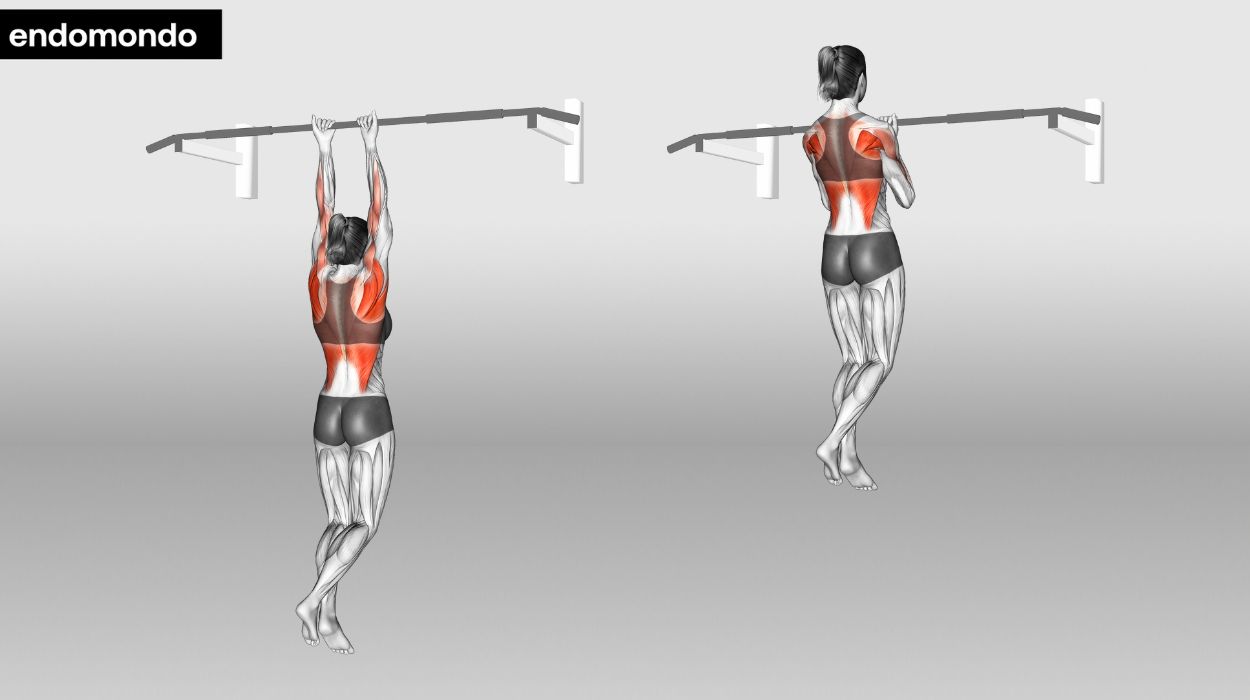
How to do:
- Grasp a pull-up bar with an underhand grip, hands positioned closer together than shoulder-width apart.
- Hang from the bar with your arms fully extended and your body straight.
- Pull yourself up by bending your elbows, bringing your chest towards the bar while keeping your elbows close to your sides.
- Lower yourself back down to the starting position with control, fully extending your arms.
- Repeat for the desired number of repetitions, focusing on engaging your back and arm muscles throughout the movement.
Tips:
- Maintain a tight grip on the bar with your palms facing towards you, hands positioned slightly closer than shoulder-width apart.
- Keep your elbows close to your sides throughout the movement to emphasize bicep and back engagement.
- Focus on pulling your chest towards the bar, squeezing your shoulder blades together at the top of the movement.
Optimal Sets and Reps: 3 sets of 6-10 reps.
Dumbbell Pull-Over
This pull-up alternative with dumbbells primarily targets the muscles of the chest (pectoralis major[1] and minor) and the latissimus dorsi (lats). The exercise is performed by lying on a bench with a dumbbell held with both hands extended above the chest. The weight is then lowered behind the head in an arc-like motion while keeping the arms slightly bent.
Performing these exercises with proper form and technique is essential. If you are new to these exercises, it is advisable to seek guidance from a qualified fitness professional to ensure safety and effectiveness.
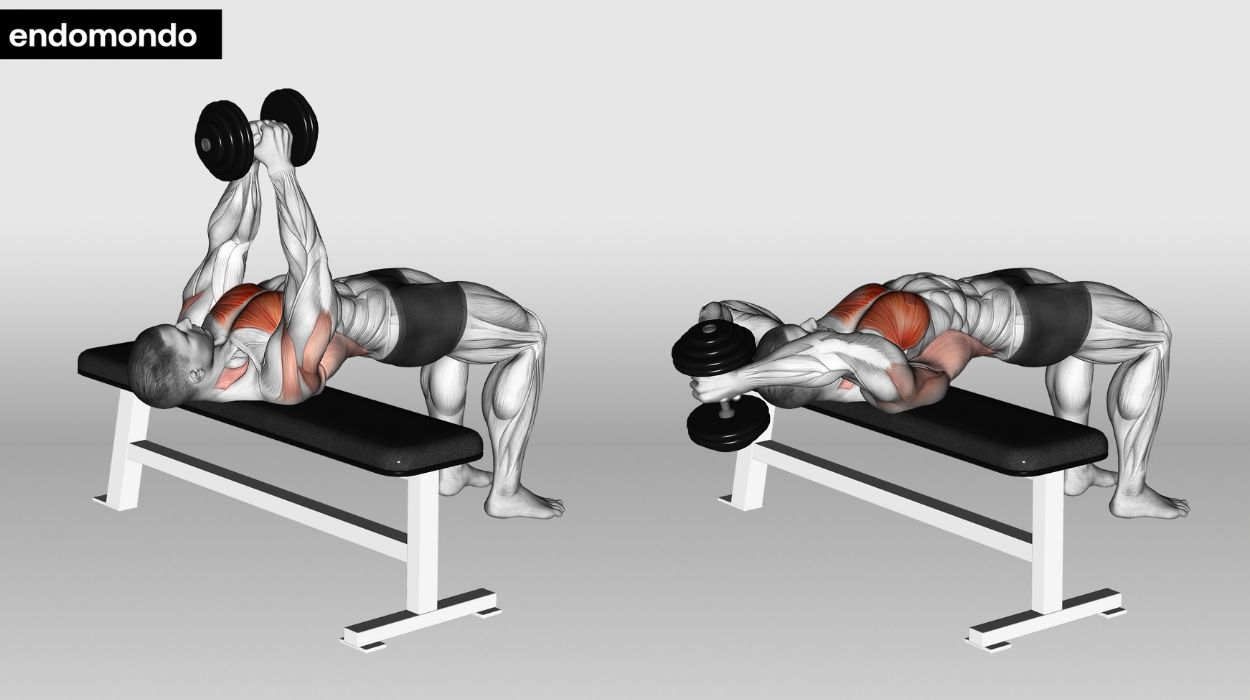
How to do:
- Lie down on a flat bench with your head and upper back supported and your feet planted firmly on the ground.
- Hold a dumbbell with both hands extended above your chest, arms slightly bent.
- Slowly lower the dumbbell back and over your head in a controlled motion until your arms are parallel to the floor or slightly below.
- Engage your lats and core to pull the dumbbell back up to the starting position, maintaining a slight bend in your elbows.
- Repeat for the desired number of repetitions, focusing on maintaining proper form and control throughout the movement.
Tips:
- Keep your core engaged and your lower back pressed against the bench throughout the movement to stabilize your spine.
- Lower the dumbbell slowly and with control, focusing on feeling the stretch in your lats.
- Exhale as you pull the dumbbell back up, squeezing your lats and chest at the top of the movement.
Optimal Sets and Reps: 3 sets of 10-12 reps.
Benefits Of Pull Up Alternative Exercises
Pull-up alternatives, such as the single-arm dumbbell row with an overhand grip, offer a range of benefits. They allow individuals to target similar muscle groups and achieve upper body strength and development.
Muscle Development
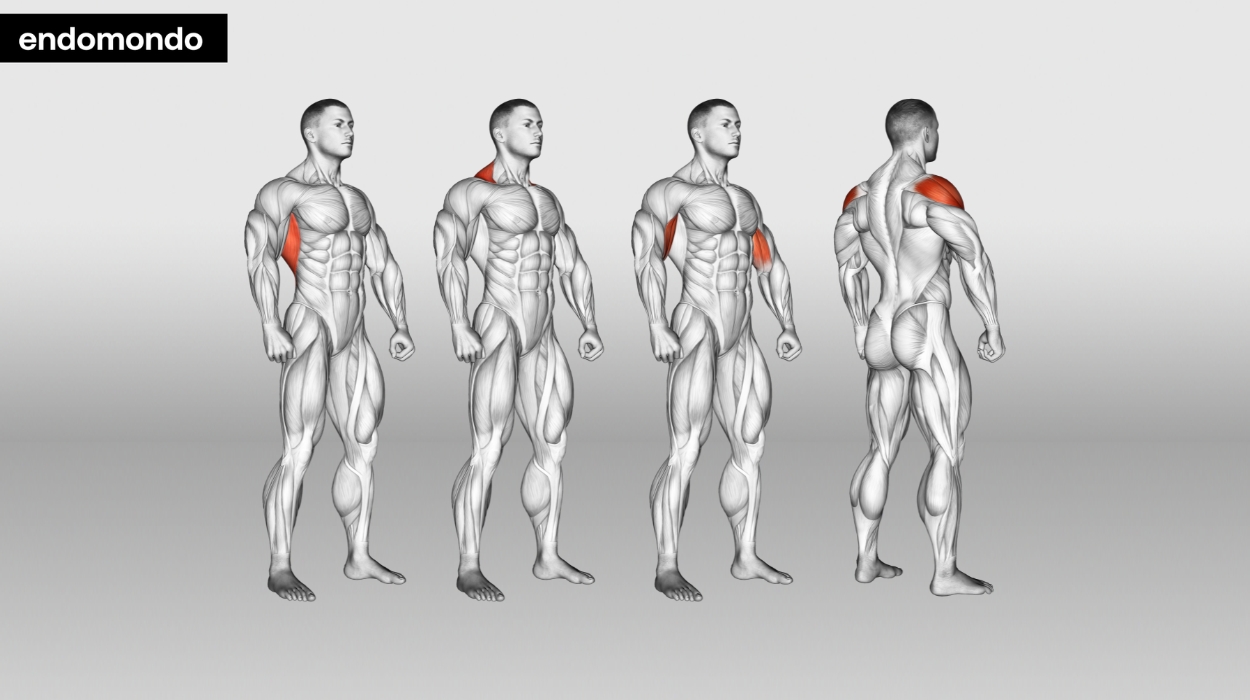
Pull-up alternatives target various muscles in the upper body, including the back, arms, and shoulders. By incorporating these exercises into your workout routine, you can effectively stimulate muscle growth and development.
The primary muscles targeted by pull-up alternatives include the latissimus dorsi[2] (lats), rhomboids, trapezius, biceps, and posterior deltoids. Engaging these muscles through alternative exercises like assisted pull-ups helps in building strength, improving muscle definition, and enhancing overall posture.
Back Strength
Strengthening muscles like the lats and rhomboids also helps improve posture, support spinal stability, and enhance functional movements involving pulling actions. Additionally, compound exercises like the pull-up exercise using just the body weight can significantly contribute to developing a strong back, reducing the risk of back pain or injuries.
Arm And Grip Strength
Many pull-up alternatives involve pulling movements that target the biceps and forearm muscles. By performing exercises like inverted rows, renegade rows, or close grip chin-ups, you can effectively strengthen these muscle groups.
Improving arm and grip strength not only enhances your ability to perform daily tasks but also benefits performance in various sports and activities that require upper body strength, such as rock climbing, grappling sports, and weightlifting, not to mention improved weight-lifting capabilities.
Scapular Stability
Pull-up alternatives often engage the muscles responsible for scapular stability.[3] The scapulae, commonly known as shoulder blades, play a crucial role in shoulder mobility and stability. Exercises like inverted rows, renegade rows, and towel rows require scapular retraction and depression, and these exercises help to strengthen the muscles that control these movements.
Developing scapular stability contributes to overall shoulder health, reduces the risk of shoulder injuries, and improves posture.
Versatility And Accessibility
Pull-up alternatives offer versatility in terms of equipment and accessibility. While traditional pull-ups require a pull-up bar or a specific apparatus,[4] pull-up alternatives can be performed with minimal equipment. Exercises like inverted rows and renegade rows can be done using a suspension trainer, resistance bands, or even a sturdy table.
This versatility allows individuals to perform these exercises at home, in the gym, or even outdoors, making them accessible to a wide range of individuals with varying fitness levels and training environments.
General Body Fitness
If your goal is to keep fit and lose weight, incorporating pull-up alternative workouts into your workout routine and complementing them with a healthy breakfast diet can help optimize your fitness journey, promote muscle development, and work towards achieving a flat stomach.
Tips When Doing Alternative To Pull Ups
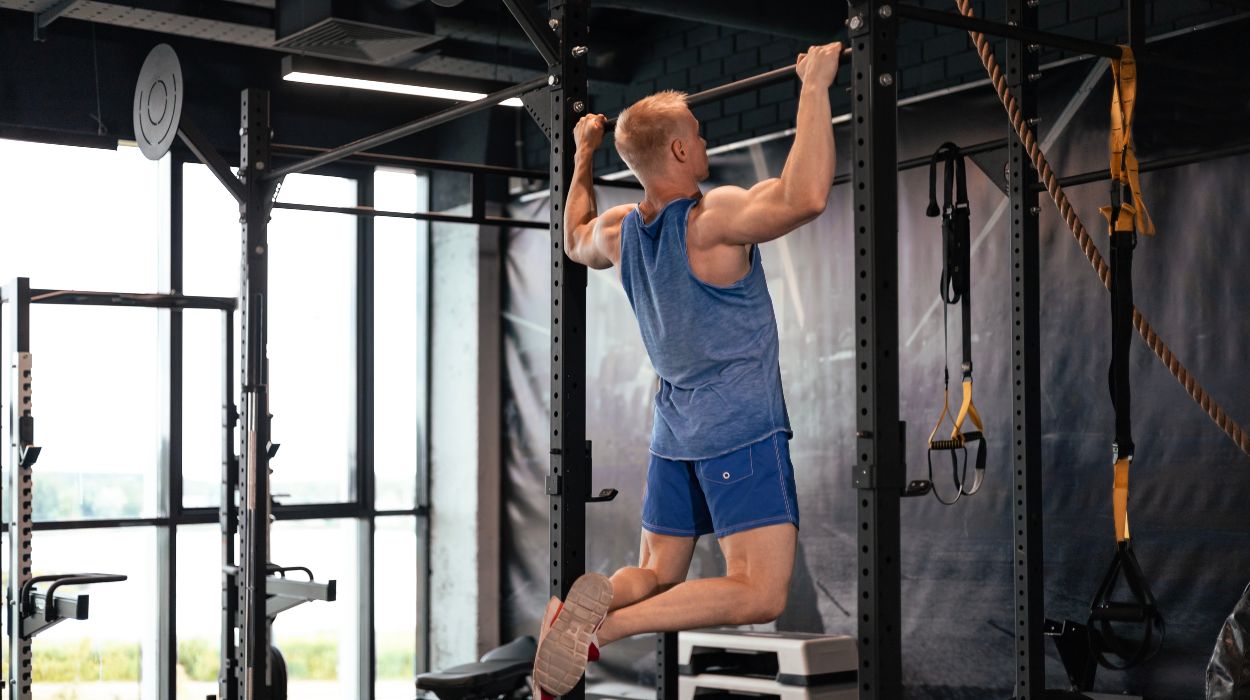
While the pull-up alternative exercises are relatively simple, they can be difficult to perform when just starting. To ensure your success, we recommend the following tips:
- Understand the muscle groups involved.
- Adjust the resistance and intensity.
- Focus on proper form.
- Vary your grip.
- Include pulling exercises in your routine.
- Progress gradually.
- Be consistent and patient.
Conclusion
Incorporating pull-up alternatives into your fitness routine can be an effective way to target the same muscle groups as traditional pull-ups while providing versatility, accessibility, and the ability to progress.
Pull-up alternatives offer numerous benefits, including muscle development, back strength, arm and grip strength, and scapular stability, among many others. You can achieve significant upper body strength, muscle definition, and improved posture by selecting the appropriate alternatives based on your fitness level and goals.
Stay consistent, be patient, and enjoy the journey to a stronger and more resilient upper body.
Frequently Asked Questions
Pull-up alternatives are exercises that target similar muscle groups as traditional pull-ups but can be performed without a pull-up bar.
Pull-up alternatives offer versatility, accessibility, and the ability to progress, making them suitable for individuals who cannot perform traditional pull-ups or lack the necessary equipment.
Yes, pull-up alternatives engage the targeted muscle groups and can effectively contribute to building upper body strength and muscle definition.
Yes. Pull-up alternatives offer various modifications and progressions that cater to different fitness levels, including beginners.
While some alternatives may require equipment like suspension trainers or resistance bands, many can be performed with minimal equipment or even using household items.
Yes, many pull-up alternatives can be done at home with minimal equipment, making them accessible for individuals who prefer to exercise in the comfort of their own space.
Resources
- Paulo Henrique Marchetti and Uchida, M.C. (2011). Effects of the Pullover Exercise on the Pectoralis Major and Latissimus Dorsi Muscles as Evaluated by EMG. Journal of Applied Biomechanics, [online] 27(4), pp.380–384. doi:https://doi.org/10.1123/jab.27.4.380.
- Jeno, S.H. and Varacallo, M. (2023). Anatomy, Back, Latissimus Dorsi. [online] Nih.gov. Available at: https://www.ncbi.nlm.nih.gov/books/NBK448120/.
- Schory, A., Bidinger, E., Wolf, J. and Murray, L. (2016). A SYSTEMATIC REVIEW OF THE EXERCISES THAT PRODUCE OPTIMAL MUSCLE RATIOS OF THE SCAPULAR STABILIZERS IN NORMAL SHOULDERS. International journal of sports physical therapy, [online] 11(3), pp.321–36. Available at: https://www.ncbi.nlm.nih.gov/pmc/articles/PMC4886800/.
- Snarr, R.L., Hallmark, A.V., Casey, J.C. and Esco, M.R. (2017). Electromyographical Comparison of a Traditional, Suspension Device, and Towel Pull-Up. Journal of Human Kinetics, [online] 58(1), pp.5–13. doi:https://doi.org/10.1515/hukin-2017-0068.




